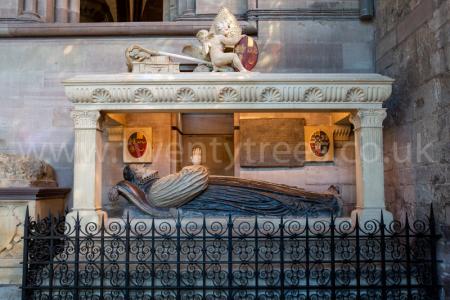Canopy
Canopy is in Architectural Detail.
On 27 Nov 1268 Bishop Peter Acquablanca died. Monument in the North Transept of Hereford Cathedral [Map] Low altar-tomb with moulded capping and plinth, and effigy in surplice, defaced head on cushion, feet on lion, remains of recumbent trefoiled canopy with crockets and trefoiled spandrels, drapery carefully rendered.
Bishop Peter Acquablanca: Bishop Peter Acquablanca was elected Bishop of Hereford. In 1263 John Giffard 1st Baron Giffard Brimpsfield was imprisoned Bishop Peter Acquablanca at Eardisley Castle.
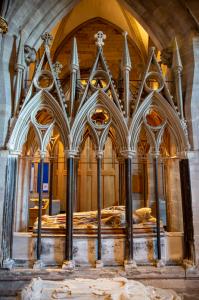
On 25 Aug 1282 Bishop Thomas Cantilupe (age 64) died in Ferento, Orvieto. Monument in the North Transept of Hereford Cathedral [Map] in the form of a shrine-pedestal and consisting of an altar-tomb and open superstructure (Plate 134), altar-tomb possibly slightly earlier than the rest, tapering on plan and re-assembled, long sides with six bays and W. end with two bays of cinque-foiled arcading on attached shafts with foliated capitals and moulded bases, spandrels carved with varying naturalistic foliage; each bay filled with figure of knight (Plate 136) with long surcoat, heater-shaped shield and feet on lions and other beasts, faces all defaced; on slab, indent of brass figure of bishop with mitre and crozier and canopy; small brass figure of St. Ethelbert now in library; superstructure with six bays on long sides and two at W. end of open trefoiled arcading resting on shafts with moulded capitals and bases, spandrels carved with naturalistic foliage and winged beasts, moulded cornice at top and plain top slab; E. end of tomb, plain and not intended to be seen, with part of carved spandrel set in it.
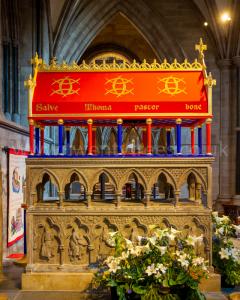
Around 1327. Lady Chapel of Hereford Cathedral [Map] Monument to Joan Plugenet of Kilpec, wife of Henry de Bohun, [1327], altar-tomb with effigy in wallrecess, plain altar-tomb with moulded top-edge enriched with Paterae and heads alternately, at head recumbent canopy with ogee cinque-foiled arch, crockets and finial; effigy of woman in wimple and veiled head-dress, tight sleeves and loose gown, head on cushion and feet on dog; all set in a 13th-century recess with moulded and segmental-pointed arch and label with head-stops and apex turned up to mitre with string-course of chapel; remains of black and red colour on effigy and arch, traces of painted figure and arch on back of recess and remains of decoration in spandrels of arch, including a diaper of fleur-de-lis and rosettes and two shields-of-arms (a) Plunkenet and (b) formerly Bohun but now obliterated.  Bohun Arms.
Bohun Arms.  Pye Arms.
Pye Arms.
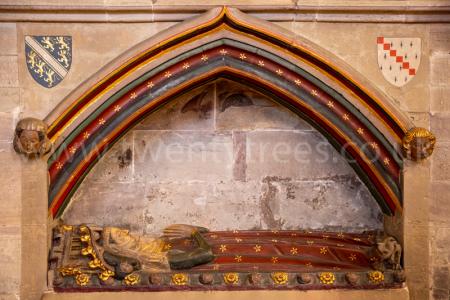
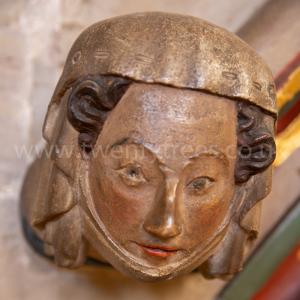
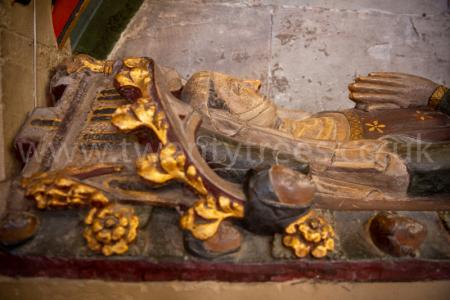
After 10 Aug 1358. Monument to Piers Grandison 2nd Baron Grandison. Lady Chapel of Hereford Cathedral [Map]. Mid 14th-century, altar-tomb with effigy and canopy, altar-tomb with range of cinquefoil-headed panels in front and panelled buttresses at ends carried up to the cornice of the canopy, effigy in mixed mail and plate-armour with camail and ridged bascinet, hauberk with scalloped lower edge, cyclas, enriched Hip Belt with dagger hanging in front and sword at side, head on cushions and feet on hound; recess with panelled back, moulded jambs and square head enriched with Paterae and trefoiled and sub-cusped pendant tracery below the head; vaulted soffit to canopy; canopy with range of six bays of open arcading with trefoiled and sub-cusped heads, crockets and finials, in arcading two headless figures of the Coronation of the Virgin, headless figure with book, archbishop with cross-staff, St. John the Baptist holding a roundel with the Agnus Dei, and a bishop, last four figures brought from elsewhere; canopy finished with enriched cornice and pierced parapet with quatrefoils and cusped cresting.
Piers Grandison 2nd Baron Grandison: he was born to William Grandison 1st Baron Grandison and Sibylla Tregoz Baroness Grandison at Ashperton, Ledbury. On 27 Jun 1335 William Grandison 1st Baron Grandison died at Lambourne, Berkshire. His son Piers Grandison 2nd Baron Grandison succeeded 2nd Baron Grandison. Blanche Mortimer Baroness Grandison by marriage Baroness Grandison. In or before 1340 Piers Grandison 2nd Baron Grandison and Blanche Mortimer Baroness Grandison were married. She the daughter of Roger Mortimer 1st Earl March and Joan Geneville Baroness Mortimer 2nd Baroness Geneville. She a great x 4 granddaughter of King John "Lackland" of England. On 10 Aug 1358 Piers Grandison 2nd Baron Grandison died at Ashperton, Ledbury. His brother Bishop John Grandison 3rd Baron Grandison succeeded 3rd Baron Grandison.
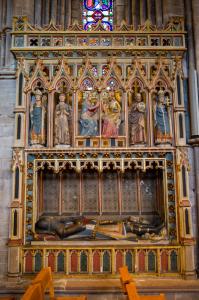
In 1435 Richard Delamere died, and Isabel his wife, died 1421. Monument in the North Transept of Hereford Cathedral [Map]. Figure of man in plate armour, feet on lion, figure of lady in horned headdress and SS collar, two dogs at feet, double canopy with cinque-foiled and sub-cusped arches and crocketted ogee gables and upper cornice, parts of standards and pinnacles missing, foot inscription and three shields-of-arms (a) Delamere, (b) the same impaling Acton.
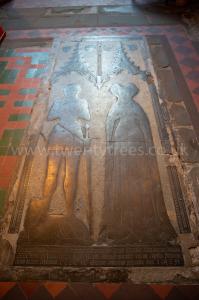
On 29 Aug 1582 Thomas St Paul died. He was buried at St Lawrence's Church, Snarford [Map]. Monument to Thomas St Paul and Faith Grantham. Fine freestanding tomb chest with canopy. The sides of the tomb chest have acanthus Pilasters, the panels between contain wreathed shields. The full length recumbent albaster effigies show the man in full plate armour holding sword and prayerbook, head on helm, feet on a cushion with flowers. His wife is in a long dress with cloak and close fitting hat, holding a bible. The inscription runs round the top edge of the chest. The canopy is supported on six pillars, those at the angles being circular and bulbous, the others in the form of obelisks decorated with fishscale Paterae, with elaborate Ionic Capitals with roses in the necking. The entablature has an egg and dart frieze. Above the heads of the columns are five female and one male weepers. At the centre of the canopy is a raised altar bearing shields and surmounted by the kneeling figure of the heir clad in armour. In front kneels a larger figure of a girl. the monument is all painted and gilded.
Thomas St Paul: he and Faith Grantham were married. he was appointed High Sheriff of Lincolnshire. In 1580 Thomas St Paul was knighted by Queen Elizabeth I of England and Ireland at Richmond, Surrey.
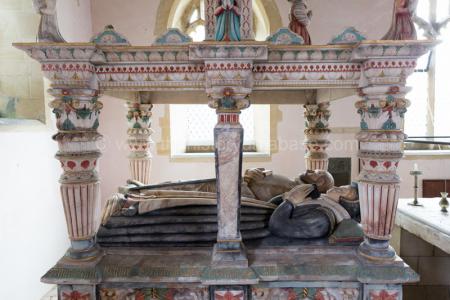
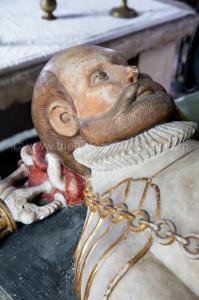

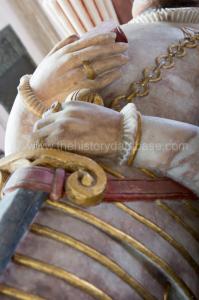
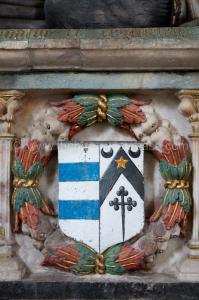
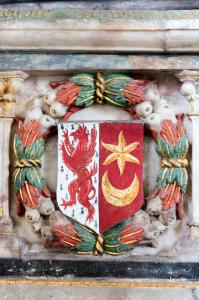
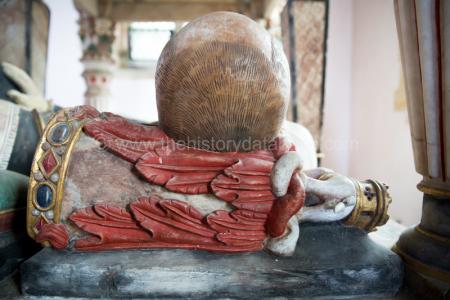
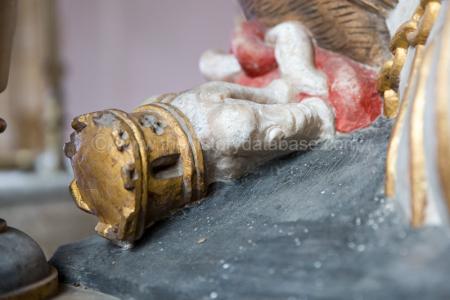
On 04 Aug 1598 William Cecil 1st Baron Burghley (age 77) died. His son Thomas Cecil 1st Earl Exeter (age 56) succeeded 2nd Baron Burghley. He was buried at St Martin's Church, Stamford [Map] with a large free-standing Elizabethan Period monument under the north chapel arch, in coloured marbles with a figure on tomb chest under an arched canopy supported on paired columns. Attributed to Cornelius Cure. The emblem of the Knights of the Garter on William's left shoulder. Leg Garter. In his right-hand he is holding the Lord Treasurer Staff of Office; originally white.
The inscription one the monument is on contained within three panels: two on the south (Chancel) side, and one on the north (Chapel) side.
Sacred to God most good and great, and to memory. The most honourable and far renowned Lord William Cecil, Baron of Burghley, Lord High Treasurer of England, President of the Court of Wards, knight of the most noble order of the Garter, Privy Counsellor to the most serene Elizabeth, Queen of England, &c., and Chancellor of the University of Cambridge, under this tomb awaits the second coming of Christ: Who for the excellent endowments of the mind, was first made Privy Counsellor to Edward the sixth, King of England; afterwards to Queen Elizabeth: under whom being intrusted with the greatest and most weighty affairs of this kingdom, and above all others approved, in promoting the true religion, and providing for the safety and honour of the commonwealth; by his prudence, honesty, integrity, and great services to the nation, he obtained the highest honours: and when he had long enough to nature, long enough for glory, but not long enough to his country, quietly fell asleep in Christ. He had two wives: Mary, sister of Sir John Cheeke, knight, of whom ie begat one son, Thomas (age 56), now Baron of Burghley; and Mildred, daughter of Sir Anthony Cooke, knight, who bore to him Sir Robert Cecil (age 35), knight, Privy Counsellor to Queen Elizabeth and President of the Court of Wards; Anne, married to Edward, Earl of Oxford (age 48); and Elizabeth (age 34) to William Wentworth, eldest son of Baron Wentworth.


Mary Cheke: she was born to Peter Cheke. In 1541 William Cecil 1st Baron Burghley and she were married. In Feb 1543 Mary Cheke died.
Elizabeth Cecil: On 01 Jul 1564 she was born to William Cecil 1st Baron Burghley and Mildred Cooke Baroness Burghley. On 26 Feb 1582 William Wentworth and she were married.
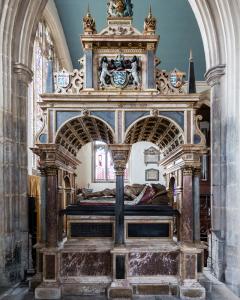
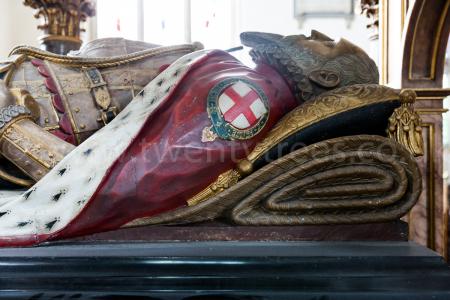
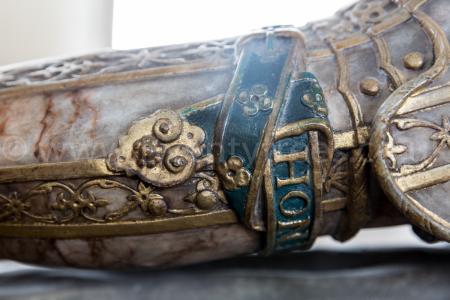

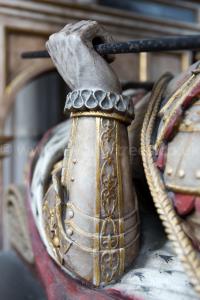
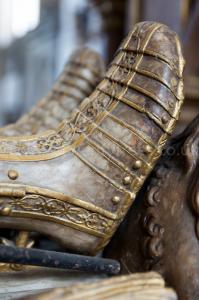
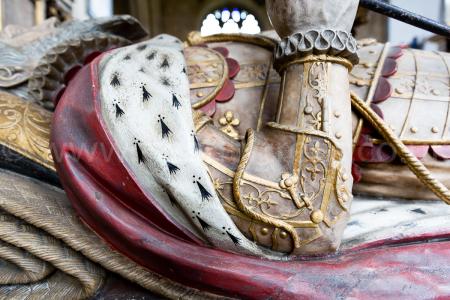
In 1625 John Sydenham V (age 57) died. Monument at St Andrew's Church, Brympton d'Evercy [Map].
A Corinthian column at each corner supports the fine canopy, and the whole is adorned withmany coats of arms, which,commencing on the north side, illustrate, as it were, the pedigree of the family. On either side the canopy is surmounted by the arms ofSir John Sydenham, on the north impaling those of his first wife, and on the south the arms of his second;each coat is flanked by a small shield supported by a ram. Bound the edge of the canopy are thirteen shields, on which are impaled the arms brought inby various atches. On each side of the tomb itself are three large shields:those on the north side bearing the arms of Sydenham, impaling those of Audley Arm, Bruges, and  Godolphin Arms, with their various quarterings;on the south are the arms of John Sydenham (age 36), who erected the monument, his sister impaled with those of her husband Edward Paston, and another coat in which the sinister side is not filled in. Probably it was meant to await the marriage of Sir Balph Sydenham (age 34), a younger brother of the founder. At the west end base is the large quartered coat of Sir John Sydenham, impaling the arms of Buckland with its nine quarterings. At the head of the tomb, surmounted by the helmet, crest, and lambrequin, is the-Sydenham coat of twelve quarterings, beneath which is the following inscription:
Godolphin Arms, with their various quarterings;on the south are the arms of John Sydenham (age 36), who erected the monument, his sister impaled with those of her husband Edward Paston, and another coat in which the sinister side is not filled in. Probably it was meant to await the marriage of Sir Balph Sydenham (age 34), a younger brother of the founder. At the west end base is the large quartered coat of Sir John Sydenham, impaling the arms of Buckland with its nine quarterings. At the head of the tomb, surmounted by the helmet, crest, and lambrequin, is the-Sydenham coat of twelve quarterings, beneath which is the following inscription:
My foundir Sydenham, match'd with Hobye's Heyr,.
Badde me inform thee (gentle Passenger).
That what hee hath donne in mcc is onlie meant.
To memorize his father and s discent.
Without vayne glorye but he doth intreat.
That if thou comst his legende to repeate.
Thou speak him truly as he was and than - Report itso, hee dyed an honest mane.
10 November 1626.
The main armorial as follows: 1 Sydenham Arms 2 Kitsford Arms 3 Dalingrige Arms 4  Hussey Arms 5
Hussey Arms 5  Stourton Arms 6 Langland Arms 7 Beaufre Arms 8 Furneux Arms 9
Stourton Arms 6 Langland Arms 7 Beaufre Arms 8 Furneux Arms 9  Godolphin Arms 10 Balune Arms 11
Godolphin Arms 10 Balune Arms 11  Killigrew Arms 12 Trenouth Arms. Source.
Killigrew Arms 12 Trenouth Arms. Source.
John Sydenham V: In 1568 he was born to John Sydenham IV "The Elder" and Grace Godolphin.
John Sydenham: In 1589 he was born to John Sydenham V. In 1627 John Sydenham died.
Ralph Sydenham: In or after 1590 he was born to John Sydenham V. In 1671 Ralph Sydenham died.
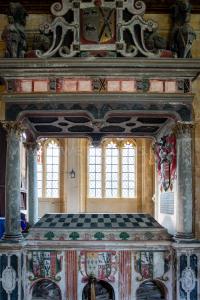
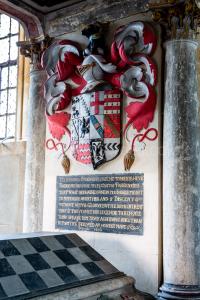
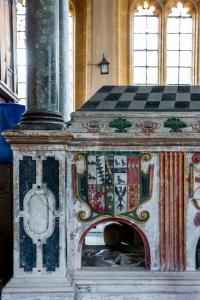
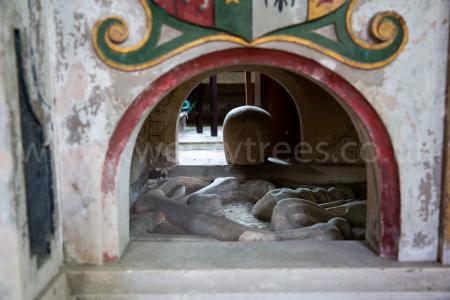
Evelyn's Diary. 22 Oct 1644. Under the Court of Justice is a stately arcade for men to walk in, and over that, the shops of divers rare artists who continually work for the great Duke. Above this is that renowned Ceimeliarcha, or repository, wherein are hundreds of admirable antiquities, statues of marble and metal, vases of porphyry, etc.; but among the statues none so famous as the Scipio, the Boar, the Idol of Apollo, brought from the Delphic Temple, and two triumphant columns. Over these hang the pictures of the most famous persons and illustrious men in arts or arms, to the number of 300, taken out of the museum of Paulus Jovius. They then led us into a large square room, in the middle of which stood a cabinet of an octangular form, so adorned and furnished with crystals, agates, and sculptures, as exceeds any description. This cabinet is called the Tribuna and in it is a pearl as big as an hazelnut. The cabinet is of ebony, lazuli, and jasper; over the door is a round of M. Angelo; on the cabinet, Leo X. with other paintings of Raphael, del Sarto, Perugino, and Correggio, viz, a St. John, a Virgin, a Boy, two Apostles, two heads of Durer, rarely carved. Over this cabinet is a globe of ivory, excellently carved; the Labors of Hercules, in massy silver, and many incomparable pictures in small. There is another, which had about it eight Oriental columns of alabaster, on each whereof was placed a head of a Cæsar, covered with a canopy so richly set with precious stones, that they resembled a firmament of stars. Within it was our Savior's Passion, and the twelve Apostles in amber. This cabinet was valued at two hundred thousand crowns. In another, with calcedon pillars, was a series of golden medals. Here is also another rich ebony cabinet cupolaed with a tortoise shell, and containing a collection of gold medals esteemed worth 50,000 crowns; a wreathed pillar of Oriental alabaster, divers paintings of Da Vinci, Pontorno, del Sarto, an Ecce Homo of Titian, a Boy of Bronzini, etc. They showed us a branch of coral fixed on the rock, which they affirm does still grow. In another room, is kept the Tabernacle appointed for the chapel of St. Laurence, about which are placed small statues of Saints, of precious material; a piece of such art and cost, that having been these forty years in perfecting, it is one of the most curious things in the world. Here were divers tables of Pietra Commesso, which is a marble ground inlaid with several sorts of marbles and stones of various colors representing flowers, trees, beasts, birds, and landscapes. In one is represented the town of Leghorn, by the same hand who inlaid the altar of St. Laurence, Domenico Benotti, of whom I purchased nineteen pieces of the same work for a cabinet. In a press near this they showed an iron nail, one half whereof being converted into gold by one Thurnheuser, a German chemist, is looked on as a great rarity; but it plainly appeared to have been soldered together. There is a curious watch, a monstrous turquoise as big as an egg, on which is carved an emperor's head.
Evelyn's Diary. 19 Nov 1644. Having seen this, we descended into the body of the church, full of collateral chapels and large oratories, most of them exceeding the size of ordinary churches; but the principal are four incrusted with most precious marbles and stones of various colors, adorned with an infinity of statues, pictures, stately altars, and innumerable relics. The altar-piece of St. Michael being of Mosaic, I could not pass without particular note, as one of the best of that kind. The chapel of Gregory XIII., where he is buried, is most splendid. Under the cupola, and in the center of the church, stands the high altar, consecrated first by Clement VIII., adorned by Paul V., and lately covered by Pope Urban VIII.; with that stupendous canopy of Corinthian brass, which heretofore was brought from the Pantheon; it consists of four wreathed columns, partly channelled and encircled with vines, on which hang little puti birds and bees (the arms of the Barberini), sustaining a baldacchino of the same metal. The four columns weigh an hundred and ten thousand pounds, all over richly gilt; this, with the pedestals, crown, and statues about it, form a thing of that art, vastness, and magnificence, as is beyond all that man's industry has produced of the kind; it is the work of Bernini, a Florentine sculptor, architect, painter, and poet, who, a little before my coming to the city, gave a public opera (for so they call shows of that kind), wherein he painted the scenes, cut the statues, invented the engines, composed the music, writ the comedy, and built the theater. Opposite to either of these pillars, under those niches which, with their columns, support the weighty cupola, are placed four exquisite statues of Parian marble, to which are four altars; that of St. Veronica, made by Fra. Mochi, has over it the reliquary, where they showed us the miraculous Sudarium indued with the picture of our Savior's face, with this inscription: "Salvatoris imaginem Veronicæ Sudario exceptam ut loci majestas decentèr custodiret, Urbanus VIII. Pont. Max. Marmoreum signum et Altare addidit, Conditorium extruxit et ornavit"..
After 10 Dec 1646 a cenotaph to Bishop George Coke (deceased) was erected in his memory in the South East Transept of Hereford Cathedral [Map]. Effigy in Rochet, chimere, ruff and skull-cap, head on tasselled cushion, base and canopy modern.
